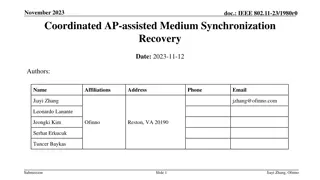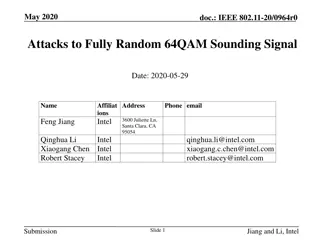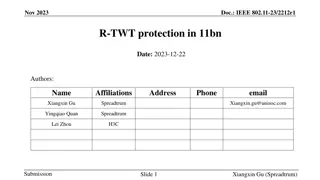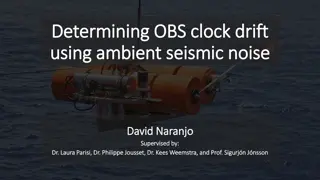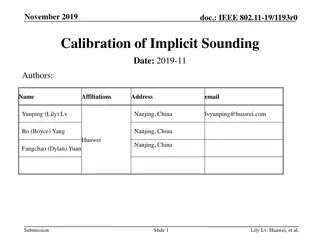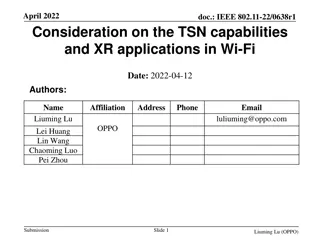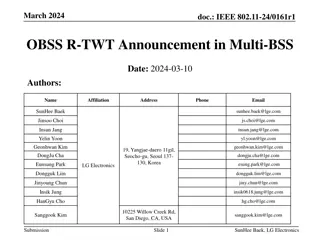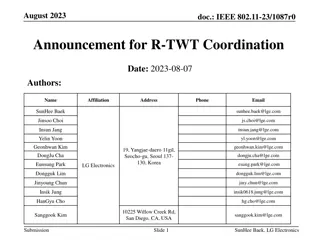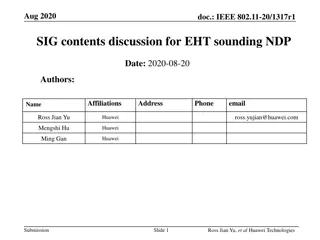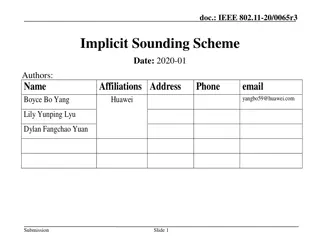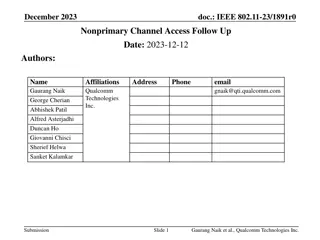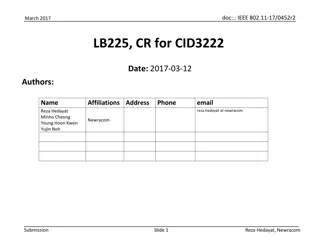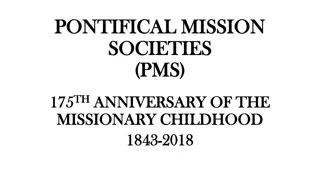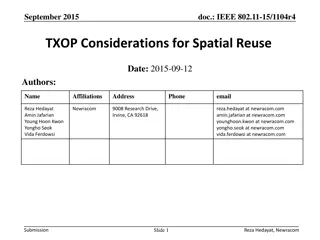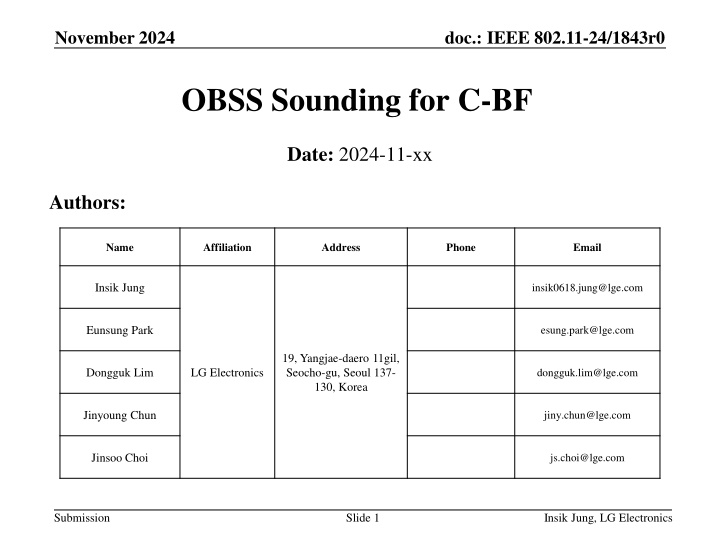
Enhancing OBSS Sounding for Coordinated Beamforming in IEEE 802.11-24
Explore how OBSS sounding is crucial for coordinated beamforming in IEEE 802.11-24, focusing on addressing OBSS interference, signaling mechanisms, and optimizing performance for C-BF technology. The proposal suggests improvements in OBSS channel feedback, sounding procedures, and the negotiation of NDP/NDPA capabilities between APs. Additionally, it addresses challenges in delivering OBSS CSI information effectively to the intended APs while minimizing computational burden on client STAs.
Download Presentation

Please find below an Image/Link to download the presentation.
The content on the website is provided AS IS for your information and personal use only. It may not be sold, licensed, or shared on other websites without obtaining consent from the author. If you encounter any issues during the download, it is possible that the publisher has removed the file from their server.
You are allowed to download the files provided on this website for personal or commercial use, subject to the condition that they are used lawfully. All files are the property of their respective owners.
The content on the website is provided AS IS for your information and personal use only. It may not be sold, licensed, or shared on other websites without obtaining consent from the author.
E N D
Presentation Transcript
November 2024 doc.: IEEE 802.11-24/1843r0 OBSS Sounding for C-BF Date: 2024-11-xx Authors: Name Affiliation Address Phone Email Insik Jung insik0618.jung@lge.com Eunsung Park esung.park@lge.com 19, Yangjae-daero 11gil, Seocho-gu, Seoul 137- 130, Korea Dongguk Lim LG Electronics dongguk.lim@lge.com Jinyoung Chun jiny.chun@lge.com Jinsoo Choi js.choi@lge.com Submission Slide 1 Insik Jung, LG Electronics
November 2024 doc.: IEEE 802.11-24/1843r0 Introduction OBSS sounding is one of key feature to realize coordinated beamforming (C-BF) technology BSS STA estimates DL channel which comes from OBSS AP We simply point out that some signaling in NDPA might be required to trigger OBSS NDP To prevent the OBSS packet decoding burden on the STA side, [1]-[3] have proposed using NDPA or BFRP Trigger frame only towards the in-BSS stations. Therefore, AP need to overhear the required OBSS channel feedback matrix from the OBSS stations. In this contribution, we propose a method to improve the overhearing performance to realize C-BF Submission Slide 2 Insik Jung, LG Electronics
November 2024 doc.: IEEE 802.11-24/1843r0 OBSS Sounding (1/2) Basic sounding principle proposed in [1]-[3] is as follows NDPA and BFRP trigger only address the BSS stations This is because addressing OBSS STA makes STAs to decode every OBSS packets, which can be huge computation burden We agree with this direction to minimize impact to client STAs NDPA NDP BFRP NDPA BFRP AP 1 NDP AP 2 CSI CSI STA 1 OBSS channel information BSS channel information STA 2 Submission Slide 3 Insik Jung, LG Electronics
November 2024 doc.: IEEE 802.11-24/1843r0 OBSS Sounding (2/2) For the OBSS channel sounding, AP2 has to be ready to transmit NDP in response to the AP1 s NDPA This capability of NDPA/NDP procedure between APs should be negotiated in advance AP1 may need some signaling to indicate that the NDPA is now triggering OBSS NDP Indication to trigger OBSS NDP NDPA BFRP AP 1 NDP AP 2 CSI STA 1 OBSS channel information Submission Slide 4 Insik Jung, LG Electronics
November 2024 doc.: IEEE 802.11-24/1843r0 Problem Statement (1/2) C-BF eliminates OBSS interference by applying null beamforming For this, each AP needs to know OBSS channel information But the sounding procedures proposed in [1]-[3], OBSS CSI feedback frames do not address the AP that actually needs to utilize the OBSS CSI information The AP have to overhear the OBSS CSI Other possible solutions are additionally delivering the CSI information or using wired backhaul if implemented, but it s not recommended due to medium overhead or backhaul capacity burden Submission Slide 5 Insik Jung, LG Electronics
November 2024 doc.: IEEE 802.11-24/1843r0 Problem Statement (2/2) AP 1 does not know the quality of overhearing link For this reason, BFRP would trigger the CSI feedback frame based on the quality of CSI reporting link However, receivable MCS/Nss can be different between reporting and overhearing link Note that In-BSS SNR is mostly better than OBSS SNR we may need some AP collaboration to enable AP 2 s decoding AP 1 AP 2 CSI reporting link OBSS CSI reporting link STA 1 STA 2 Submission Slide 6 Insik Jung, LG Electronics
November 2024 doc.: IEEE 802.11-24/1843r0 OBSS Overhearing Link Quality Report If AP 2 directly deliver its overhearing link quality information to AP 1, the problem can be solved L2 quality information can be one of the followings: Overhearing link SINR AP 1 can determine the MCS/Nss of the CSI report based on the overhearing link SINR Preferred MCS/Nss AP 1 can trigger with the recommended MCS/Nss from AP 2 AP 1 AP 2 L2 quality information CSI reporting link (L1, addressed) OBSS CSI reporting link (L2, overhearing) STA 1 STA 2 Submission Slide 7 Insik Jung, LG Electronics
November 2024 doc.: IEEE 802.11-24/1843r0 Required Informations We propose to deliver the following information through AP to AP signaling STA-ID: Identifier to specify a station L2 Information: Information related to the overhearing link. It can be a SINR of the overhearing link or preferred MCS/Nss We may need to signal multiple sets of (STA-ID, L2 information) Let us call this information as OBSS CSI reporting link information STA-ID L2 information STA-ID L2 information Submission Slide 8 Insik Jung, LG Electronics
November 2024 doc.: IEEE 802.11-24/1843r0 Proposed Sequence Once the overhearing link quality is obtained by AP 2, it can be transmitted anytime before the AP 1 s BFRP How AP 2 get the overhearing link quality information is TBD (e.g. from AP1 s in-BSS frame exchange or sounding) One example can be as below: NDPA BFRP AP 1 OBSS CSI reporting link information NDP AP 2 Overhearing quality acquisition CSI STA 1 STA 2 Submission Slide 9 Insik Jung, LG Electronics
November 2024 doc.: IEEE 802.11-24/1843r0 Conclusion OBSS sounding mechanism for C-BF has been handled in this contribution We simply pointed out that some signaling in NDPA might be required to trigger OBSS AP s NDP We then have pointed out the feedback overhearing problem for C-BF We found that feedback overhearing may fail because of the link quality mismatch between the BSS reporting link and the overhearing link To solve the problem, we have proposed an AP to AP frame exchange to deliver the overhearing channel quality information Submission Slide 10 Insik Jung, LG Electronics
November 2024 doc.: IEEE 802.11-24/1843r0 References [1] 11-24-1582-00, Coordinated Sounding for CoBF [2] 11-24-1568-00, Sounding Design for C-BF [3] 11-24-1542-00, Sounding Schemes for Coordinated Beamforming Submission Slide 11 Insik Jung, LG Electronics
November 2024 doc.: IEEE 802.11-24/1843r0 Straw Poll #1 Do you agree to include following to the 11bn SFD? 11bn defines sounding procedures (i.e. sequential and joint) to measure the downlink channel heading to the OBSS STAs for C-BF NDPA and BFRP frames only address the in-BSS stations in the C-BF sounding sequence. A UHR AP may indicate to another AP its capability of transmitting NDP in response to the AP s NDPA Y/N/A: // Submission Slide 12 Insik Jung, LG Electronics
November 2024 doc.: IEEE 802.11-24/1843r0 Straw Poll #2 Do you agree to include following to the 11bn SFD? UHR NDPA frame that an AP transmits may include a signaling where it enables a neighboring AP to transmit NDP Y/N/A: // Submission Slide 13 Insik Jung, LG Electronics
November 2024 doc.: IEEE 802.11-24/1843r0 Straw Poll #3 Do you agree to include following to the 11bn SFD? Defines a mechanism where an AP transmits to a neighboring AP link quality information measured from a PPDU transmitted from STAs associated with the neighboring AP that are capable of participating in C- BF Y/N/A: // Submission Slide 14 Insik Jung, LG Electronics
November 2024 doc.: IEEE 802.11-24/1843r0 Straw Poll #4 Do you agree to include following to the 11bn SFD? 11bn supports a frame containing the link quality information between the AP and a STA associated with a neighboring AP that includes information as follows STA-ID field OBSS CSI reporting link SINR or preferred MCS/Nss NOTE There can be multiple sets of the above information in a single container Y/N/A: // Submission Slide 15 Insik Jung, LG Electronics




